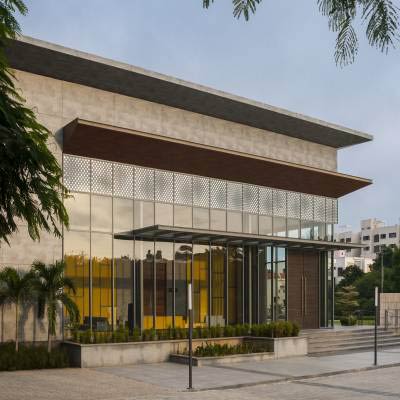

Competitors to glass in the façade market are aluminium composite panels and panels from multinational players such as FunderMax. FunderMax estimates the overall façade market, including both the branded and unbranded segments, at around 100 million sq m, growing at 7-8 per cent owing to the prevailing slowdown.
The need for standardised systems has increased, according to Ashwani Khanna, AVP Marketing, FunderMax. “RERA has brought in more accountability and quality systems and fixtures are the need of the day. FunderMax, the original with its time-tested installation systems in India, has been a frontrunner in this area.”
Façade panels play a major role in lending character to buildings, he adds, citing the Auspacious Convention Centre in Hyderabad as an example. “In particular, high-pressure laminates in accordance with EN 438-6 type EDF, manufactured with norm conformity of EN 438-7, are more suited for the various climatic conditions present in India. Max Exterior panels from FunderMax can be used for façade cladding, column cladding, soffits, louvers and various other applications, providing design freedom to architects and elegant and sustainable structures to building owners.”
At the NITTE Meenakshi School of Architecture, Bengaluru, FunderMax panels have been used as louvers.
A new solution from FunderMax, the Max Lato series is a shading system that aims to provide better visual comfort to occupants. It comes in different sizes and configurations and can be used to mitigate the effects of glare and heat ingress in different kinds of buildings located across the country. Another new system in the offering, the rivet-less soffit system from FunderMax, results in maximum material efficiency in addition to providing seamless aesthetics.
Sustainability to drive façade market
“In general, we expect great demand for sustainable material for facades of all classes of buildings, commercial and residential, with the Government being the main driving force behind such environment-responsive construction,” says Ruchi Mishra, DGM - Architect, Rudrabhishek Enterprises Ltd (REPL).
Mishra expects huge demand for steel, metal, composite wood, glass fibre-reinforced concrete and similar hybrid materials, all of which are sustainable, green and versatile. However, she also expects continued demand for conventional materials such as brick, stone and glass. For instance, REPL used granite, travertine and sandstone for the site office of its Paarth Aadyant sample flat. At Paarth Aadyant residential towers, the company used glass-reinforced concrete jaalis and facade lighting. And it used high-pressure laminate cladding with curtain glass cladding for the Paarth Republic Site and Marketing Office.